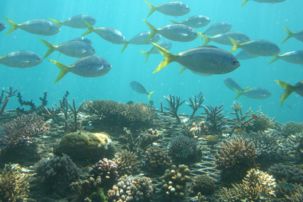Lesson summary
In this activity students either work independently or in groups to research the role that oceans have to play in the carbon cycle, and how our oceans might be affected by climate change. Students will draw their own carbon cycle and then revisit the diagram after engaging in several further research activities. Parts of this activity are adapted from: oceanlink.info.
Learning intentions:
Students will...
- recognise the role of the oceans in the carbon cycle
- understand the risks to the oceans from the climate change and the greenhouse effect
- understand what is meant by the term ‘ocean acidification’
- recognise the acidification of our oceans as one of the most significant environmental challenges we will have to face
- recognise that it won’t just be marine species and ecosystems that are impacted; humans will also be affected by ocean acidification.
Lesson guides and printables
Curriculum links
Select your curriculum from the options below.
Lesson details
Curriculum mapping
Australian Curriculum content descriptions:
Year 10 Science:
- Global systems, including the carbon cycle, rely on interactions involving the biosphere, lithosphere, hydrosphere and atmosphere (ACSSU189)
- Communicate scientific ideas and information for a particular purpose, including constructing evidence-based arguments and using appropriate scientific language, conventions and representations (ACSIS208)
Year 10 Geography
- The human-induced environmental changes that challenge sustainability (ACHGK070)
- The application of human-environment systems thinking to understanding the causes and likely consequences of the environmental change being investigated (ACHGK073)
- Present findings, arguments and explanations in a range of appropriate communication forms selected for their effectiveness and to suit audience and purpose, using relevant geographical terminology and digital technologies as appropriate (ACHGS079)
Syllabus Outcomes: GE5-2, GE5-3, GE5-8, SC5-9WS, SC5-12ES.
Time required: 120 mins
Level of teacher scaffolding: Low – oversee activity
General capabilities: Critical and creative thinking, Ethical understanding.
Cross-curriculum priority: Sustainability OI.1, OI.2.
Resources required
- Internet and computer access
- Student worksheet
- Infographic creation tool (e.g. Piktochart)
Additional info
This lesson has been created in partnership with WWF-Australia. Earth Hour is the world’s largest community-driven climate change campaign. At the centre of Earth Hour is switching off lights to show a commitment to taking action.
Thousands of teachers use Earth Hour’s education program to enrich their curriculum and provide pathways for young people to create change in their world.
For the most up to date Earth Hour dates, times, and events, check here.


Welcome back!
Don't have an account yet?
Log in with:
Create your free Cool.org account.
Many of our resources are free, with an option to upgrade to Cool+ for premium content.
Already have an account?
Sign up with:
By signing up you accept Cool.org's Terms and Conditions(Opens in new tab) and Privacy Policy(Opens in new tab).